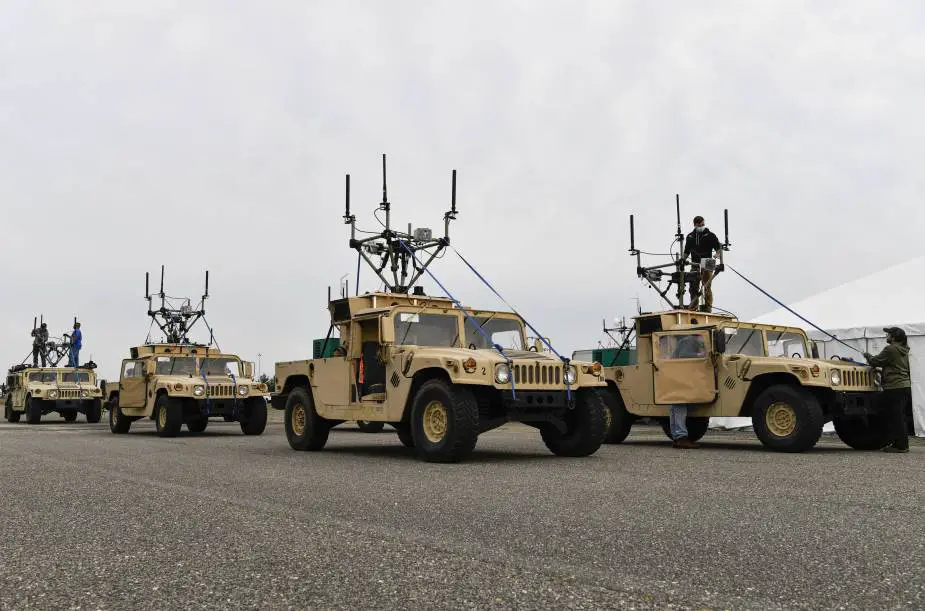Breaking news
US Army engineers field-test robotic combat vehicle communications.
U.S. Army engineers evaluated methods to improve the radio performance of Robotic Combat Vehicles (RCVs) during a field-based experiment. Jasmyne Douglas, DEVCOM C5ISR Center Public Affairs, reports.
Follow Army Recognition on Google News at this link

Humvees sit on an airfield in preparation for a radio test during the Platoon Attack Experiment, May 3, 2021, on Joint Base McGuire-Dix-Lakehurst, N.J. (Picture source: U.S. Air Force/Staff Sgt. Jake Carter)
The experiment focused on protected communications for tele-operating robotic combat vehicles under the Next Generation Combat Vehicles Cross-Functional Team’s (NGCV CFT) Manned-Unmanned Teaming (MUM-T) effort, which combines Soldiers, manned and unmanned air and ground vehicles, robotics and sensors to increase situational understanding, lethality and resiliency.
Radios will play a key component in the Optionally-Manned Fighting Vehicle’s ability to remotely control and maneuver RCVs in urban environments and varied terrain, noted Archie Kujawski, a network architect with the Command, Control, Communications, Computers, Cyber, Intelligence, Surveillance and Reconnaissance (C5ISR) Center – a component of Army Futures Command’s Combat Capabilities Development Command (DEVCOM).
“In previous years, we did a campaign of learning to evolve modeling and simulation and lab-based risk reduction events, but the rubber hits the road when you can come out to a field environment and validate modeling and simulation as well as lab results,” Kujawski said.
C5ISR Center engineers mounted radios onto multiple on-the-move vehicles to assess robustness and capacity in urban, open and wooded terrain, and resiliency during simulated electronic warfare attacks. Additionally, they explored system enhancements that increased signal strength and electronic protection. “We also assessed the radio systems using a vendor-sourced antenna which demonstrated the value of employing directional antennas to amplify our signals in the direction of friendly forces and to block enemy jammers’ effects, ensuring continuous operations across the objective,” said Dr. Michael Brownfield, the C5ISR Center’s Future Capabilities chief.
Brownfield noted the Army’s network currently uses multiple-input, multiple-output (MIMO) radios as a mid-tier transport to enable command post dispersion and to share common-operation-picture data with mobile maneuver forces. C5ISR Center engineers were able to simulate this setup by placing the technologies in a “highly dynamic, mobile environment. “The data we’re collecting will enable us to better understand how the stressed, contested and congested network will meet a multitude of emerging Army expeditionary mission requirements,” said Brownfield, who noted the findings will support network design for Capability Sets 23 and 25.
The effort is a continuation in a series of experiments conducted by the NGCV CFT and DEVCOM’s Ground Vehicle Systems Center (GVSC), to assess the effectiveness of RCV platforms at the platoon level and higher. The network-focused experiment will help to refine system requirements, reduce risk to performance and identify spectrum demands leading up to the MUM-T Phase II Soldier Operational Experiment (SOE II), at Fort Hood, Texas, in fiscal year 2022.
“We’re trying to determine how much bandwidth we can allocate to each one of our sections and then build those sections up to platoons, so this experiment is absolutely critical for us. It is one of our key enablers and proof of principle, ensuring we have enough technical data and validity around our concepts, so we know it is reasonable and fieldable,” said Christopher Ostrowski, associate director of experimental prototyping for DEVCOM GVSC.
Ostrowski said GVSC’s partnership with the C5ISR Center is a great example of “what DEVCOM does for the Army, and especially for the CFTs and our PEO colleagues. “It’s a whole-enterprise, holistic approach to capability development from initial concept to transition to the acquisition system, and it gives our warfighters unparalleled capability that they can rely upon.”
MUM-T modernizes the Army’s current fleet of vehicles to include the ability to control unmanned RCVs. The capability will positively impact Army survivability, providing Soldiers standoff to reduce the risk of casualties, allowing maneuver commanders the time and space to make critical decisions and potentially increasing the number and diversity of multi-mission payloads employed on the battlefield, said Lt. Col. Christopher Orlowski, product manager for Robotic Combat Vehicles under PEO GCS. “We don’t want Soldiers on a manned system to make contact with the enemy first. We want RCVs to make contact with the enemy first, and radio performance is critical to enabling CVs to do so,” Orlowski said. “If we can make contact with robots forward first, whether those are air or ground robots, then we can provide commanders time and space to make decisions.”
C5ISR Center resources have played a key role in helping the NGCV CFT develop a communication backbone to control RCVs "that is secure, reliable and resilient while able to support operations at relevant distances in the future environment,” said Col. Warren Sponsler, NGCV CFT’s chief of staff. “A priority for AFC and the NGCV CFT has been to conduct experimentation and Solider touchpoints as often as we can. This allows us to learn early, learn fast and be willing to fail fast. If things don’t work, we make adjustments as needed and continue the momentum forward,” Sponsler said. “We’ve been able to really capitalize on great work and partnership with the C5ISR Center. It has helped increase our warfighters’ ability to see the enemy first, make decisions faster and then execute lethal operations.”
As a follow-on to the experiment, C5ISR Center engineers are working to integrate the radios tested onto vehicles in preparation for a safety release later this year in support of the SOE II event. Lessons learned from the experiment will also help support execution for Project Convergence 21.



















